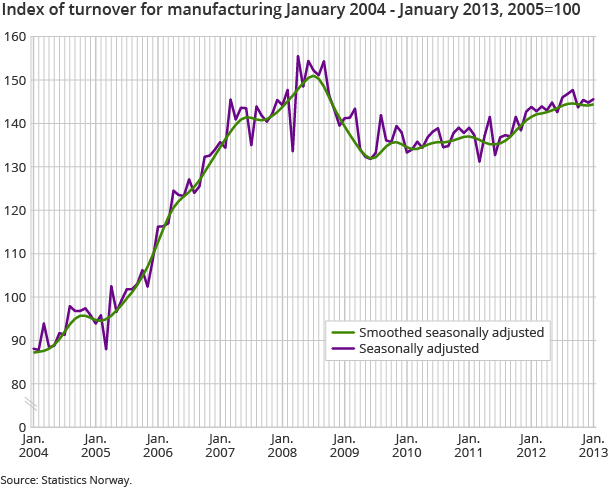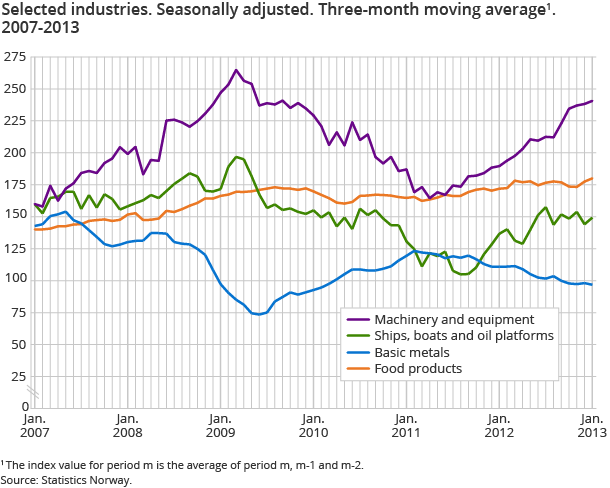Content
Published:
This is an archived release.
Stable industrial turnover
Seasonally-adjusted figures showed that the total turnover in Norwegian manufacturing decreased by 0.5 per cent from November to January 2013 compared to the previous three-month period.
| Seasonally adjusted | Unadjusted | |||
|---|---|---|---|---|
| Monthly change | Three-month change | Twelve-month change | NOK million | |
| January 2013 / December 2012 | November 2012 - January 2013 / August 2012 - October 2012 | January 2013 / January 2012 | January 2013 | |
| Extraction, mining, manufacturing and elec | -2.0 | -1.3 | -1.2 | 140 188 |
| Extraction and related services | -2.0 | -5.8 | -10.5 | 58 396 |
| Mining and quarrying | 2.7 | 20.3 | -9.6 | 1 027 |
| Manufacturing | 0.6 | -0.5 | 4.9 | 65 158 |
| Food, beverages and tobacco | -4.7 | 3.8 | 5.9 | 14 402 |
| Refined petro., chemicals, pharmac. | 3.5 | -3.6 | 1.8 | 12 590 |
| Basic metals | -1.9 | -1.0 | -14.3 | 4 511 |
| Machinery and equipment | 5.4 | 2.6 | 38.2 | 6 614 |
| Ships, boats and oil plattforms | 14.9 | 0.5 | 16.6 | 6 447 |
| Electricity, gas and steam | -7.2 | 16.1 | 16.9 | 15 607 |
The majority of the industries showed small changes in turnover in the last three-month period. The grouping refined petroleum, chemicals and pharmaceuticals fell by 3.6 per cent. This was due to lower prices within refined petroleum products. For more on this see the Producer price index. Meanwhile, fabricated metal products fell by 5.9 per cent. This downturn was within both the domestic and the export markets.
Industries with growth in turnover included machinery and equipment as well as the grouping repair and installation of machinery. These industries show continuous increases in both volume and prices. See index of production. This positive trend also applies to food products, which increased by 3.7 per cent in this period.
Increase in turnover from December to January
Seasonally-adjusted figures showed that total Norwegian manufacturing turnover went up by 0.5 per cent from December to January 2013. The largest increase was for building of ships, boats and oil platforms, by 14.8 per cent. Basic chemicals went up by 8.6 per cent, which can be partially explained by higher prices from November to January this year.
On the other hand, rubber and plastic products, and fabricated metal products went down by 3.5 per cent, while wood and wood products fell by 4.9 per cent.
Large growth within machinery and equipment
Unadjusted figures showed an increase of 4.8 per cent in total manufacturing turnover in January 2013 compared to January 2012. The largest growth in turnover was for machinery and equipment, up by a solid 38.2 per cent. This was followed by building of ships, boats and oil platforms, rising 16.6 per cent. Repair and installation of machinery rose by 11.7 per cent. These industries are important suppliers to the oil and gas industry. This can explain the boost in turnover that these industries are currently experiencing. Another industry with high levels of turnover in this period was food products, increasing 5.1 per cent.
Industries with reduced turnover were basic metals, down 14.2 per cent and paper and paper products, with a fall of 13.3 per cent.
Norway and the euro area
Seasonally-adjusted figures show that Norwegian manufacturing turnover went down 0.4 per cent from October to November 2012. Manufacturing turnover in the euro area went up 0.6 per cent in the same period, according to figures published by Eurostat.
The relationship between production and turnoverOpen and readClose
The development in turnover can be related to changes in both volume and prices in the different industries. Production to stocks and sales from stocks can also take place. Reporting of large deliveries of capital goods can contribute to differences in the development in the index of production and the statistics on turnover.
Find more figures
Find detailed figures from Turnover in oil and gas, manufacturing, mining and electricity supply
Additional information
The variation in manufacturing turnover can be related to changes in volume and price indices in different industries and also production to stocks and sales from stocks.
Contact
-
Robert Skotvold
E-mail: robert.skotvold@ssb.no
tel.: (+47) 40 90 24 44
-
Anne Karin Linderud Haugen
E-mail: anne.karin.linderud.haugen@ssb.no
tel.: (+47) 91 88 19 76


